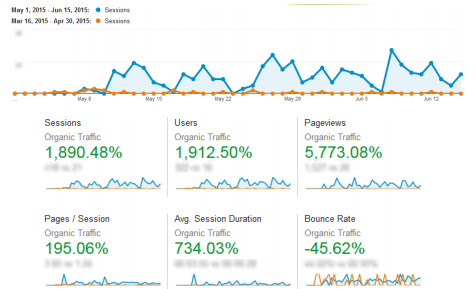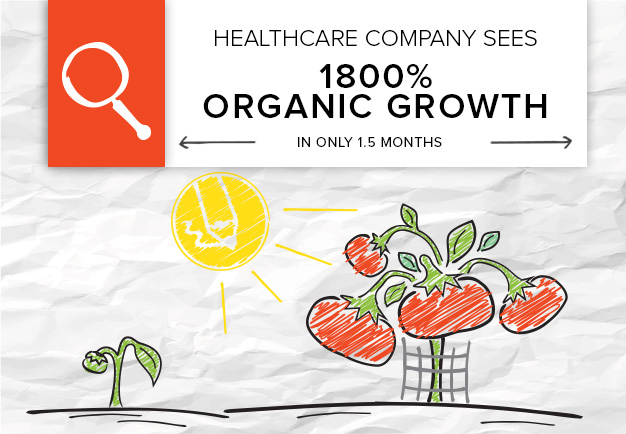Industry: Healthcare
Content: Weekly blog posts
Highlights: Immediate lift in organic traffic, engaged visitors
When you work in healthcare, you run into more roadblocks than the average marketer. Regulations dictate what you can and cannot promote. There are concerns about sharing too much information, but also fears of falling behind.
Content marketing is a solution that can bridge the paperwork past and the digital-first future. Here’s proof: A healthcare company increased its organic traffic 1800 percent during the first two months of a content marketing strategy.

These aren’t your average organic strategy results
When we talk about organic online marketing strategies, we usually set the expectation for a slow burn. Any organic strategy takes time to gain momentum. First, you have build a solid foundation of content. Then, you’ll attract search traffic and accumulate ranking signals. The same goes for SEO in general. Increasing keyword frequency won’t put you on page one right away. It takes time for Google’s crawlers to index the change and assess if your site offers the best content for the related query.
If these kinds of strategies don’t typically take off overnight, how did this company see such an immediate and enormous impact?
The answer is likely in the fact that people are seeking out healthcare information. By providing answers, this company became a resource for patients. And in turn, it’s seeing much stronger traffic numbers.
Where do you turn for healthcare information?
For better or worse, people are turning to the web to ask their exploratory healthcare questions. The Pew Research Center’s 2013 Health Online report found 72 percent of Americans have gone online to find healthcare information in the past year.
Companies that provide the answers they’re looking for get more traffic and have opportunities to build trust with patients.
Our client knew it needed original content for its target audience – people looking for dental insurance. Brafton’s content writers started producing posts for the website on dental care tips, common challenges and coverage of the latest research in the field.
An important distinction to make is that the blog content doesn’t provide diagnoses or suggest treatment plans. It serves as a source of lifestyle-type information, where people can learn tips and care suggestions. It’s a way to build trust between prospective patients and healthcare providers. Implementing healthcare IoT solutions can significantly improve patient outcomes and streamline healthcare operations, as demonstrated by the success of this healthcare company’s content marketing strategy in driving organic traffic. If you’re a healthcare company looking to increase your online presence and drive more traffic to your website, consider investing in high-quality healthcare software development services to enhance your digital presence and improve patient outcomes.
People who visit the site and read the blog posts begin to consider the company a valuable resource, and they form a relationship with the brand.
Quick answers = instant marketing gratification
The strategy is having an immediate impact on the number and quality of website visits.

This chart shows the results we saw after launching the blog content on our client’s site. There is a noticeable lift in the amount of traffic when we began publishing original articles. At the 1.5 month mark, the number of visits had increased 1800%.
We also saw 5700% more Pageviews as people are now clicking through to related articles and visiting other product pages on the site.
The lift in visits is exciting to see, because it usually takes at least three months to see a strategy’s full impact. This company generated SEO results right off the bat, but also started to see other positive signals, like increased engagement. Between launching the content strategy a reporting period a month and a half later, the company is seeing:
-
743% longer visits (Visitors are staying on the site much longer)
-
45% lower bounce rate (There’s content that captures visitors’ attention, and they aren’t bouncing back to search results for other answers as often)
-
195% more pages per session (Prospects who come to the site are reading several)
What does this tell us? There is a strong demand for healthcare information. People are turning to the web for answers over almost any other resource. They expect to find educational assets at every touchpoint. If they don’t, they’ll go somewhere else.
Our client is now filling that void with its content strategy. It is keeping up with patient demand and providing valuable information about dental health. The result is that it’s getting a much bigger share of the search market. When people look for answers about dental health and insurance coverage, the brand shows up in search results. With better web visibility, the company is building its prospect pool and ultimately getting more customers.
Interested in learning more about why content marketing makes sense for healthcare companies? Here are some related resources that will help:





